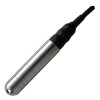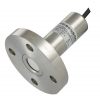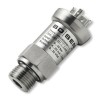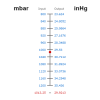I have level data from a non-vented transducer in a water body and barometric pressure data from the same location. My elevation is 500 meters, how do I determine the true depth?
The true depth can be calculated by subtracting the actual atmospheric air pressure from absolute referenced level data.
Typically a non-vented depth transducer will have an absolute range, but this should be verified by checking the reading at zero depth, which should be around 10 mH20 or 1 bar, which would signify that the transducer does indeed have an absolute reference.
Featured non-vented reference hydrostatic level measurement products
 S12C SDI-12 Seawater Pressure & Temperature Transducer - SDI-12 protocol transducer for sensing water depth level and temperature in seawater, brackish water, tidal water, saline water or leachate.
S12C SDI-12 Seawater Pressure & Temperature Transducer - SDI-12 protocol transducer for sensing water depth level and temperature in seawater, brackish water, tidal water, saline water or leachate. LMK457 Marine Approved Level Transmitter - Marine approved level transmitter with 4-20mA current loop output for shipbuilding with optional all CuNiFe construction for sea-water compatibility in ranges from 0.4 mH2O to 250mH2O gauge.
LMK457 Marine Approved Level Transmitter - Marine approved level transmitter with 4-20mA current loop output for shipbuilding with optional all CuNiFe construction for sea-water compatibility in ranges from 0.4 mH2O to 250mH2O gauge.
If the reading is close to zero, it will most likely be a sealed gauge reference type instead, this means that it will have a fixed zero offset that will typically correspond 1 bar, which will need to be determined precisely by subtracting the zero depth reading from the actual atmospheric air pressure and then adding the result to all non-vented depth readings, e.g. if Zero depth = -50 mbar, Atmospheric pressure = 980 mbar, then 1030 mbar should be added to all the depth data to convert it to absolute readings.
If the barometric pressure is the actual pressure at that location without any meteorological adjustment for elevation you can simply subtract that reading from the absolute referenced level reading, but be careful to ensure all calculations are carried out in the same pressure units.
If the barometric pressure was obtained from a meteorological service or barometer it is most likely to be referenced to sea level and you will need to compensate it for the 500m elevation by using a barometric formula to calculate corrected pressure for elevation.
Featured barometric pressure measurement products
 Marine approved atmospheric pressure sensor - Marine-approved pressure sensor for atmospheric pressure measurement on ships. 4-20mA output, 800-1200mbar range.
Marine approved atmospheric pressure sensor - Marine-approved pressure sensor for atmospheric pressure measurement on ships. 4-20mA output, 800-1200mbar range. Atmospheric range for 4-20mA pressure sensor - Do you have 4-20mA pressure sensor that can be used to measure ambient atmospheric pressure? Yes, the DMP331 has the option for a 4-20mA output scaled from 800 to 1200 mbar, but you can also specify a different scaling if necessary here.
Atmospheric range for 4-20mA pressure sensor - Do you have 4-20mA pressure sensor that can be used to measure ambient atmospheric pressure? Yes, the DMP331 has the option for a 4-20mA output scaled from 800 to 1200 mbar, but you can also specify a different scaling if necessary here.
Related Help Guides
- Difference between vented and non-vented water level measurement
- Atmospheric pressure compensation for hydrostatic level sensors
- Using absolute pressure sensors to measure hydrostatic level
- Simulating 8000 foot altitude with a pressure gauge
- Measuring barometric pressure using a dp sensor
Related Technical Terms
- at – Technical Atmosphere Pressure Unit
- atm – Standard Atmosphere Pressure Unit
- inHg – Inches of Mercury at 0 degrees C Pressure Unit
- MSL – Mean Sea Level
Related Online Tools
- Gauge + Barometric to Absolute Pressure Calculator
- Suction Pressure to Vacuum Calculator
- US Standard Atmosphere Altitude and Pressure Calculator
- ICAO Standard Atmosphere Altitude and Pressure Calculator
- Elevation, Station (QFE) and Sea Level (QNH) Pressure Calculator
Related Product and Application Guides
Related Application Questions and Answers
- Atmospheric range for 4-20mA pressure sensor
- 5 to 20 psi absolute ambient 4 to 20 ma pressure transmitter
Contact us about this Converting non-vented depth readings & barometric pressure to true depth page to request more information, or to discuss your application requirements.

